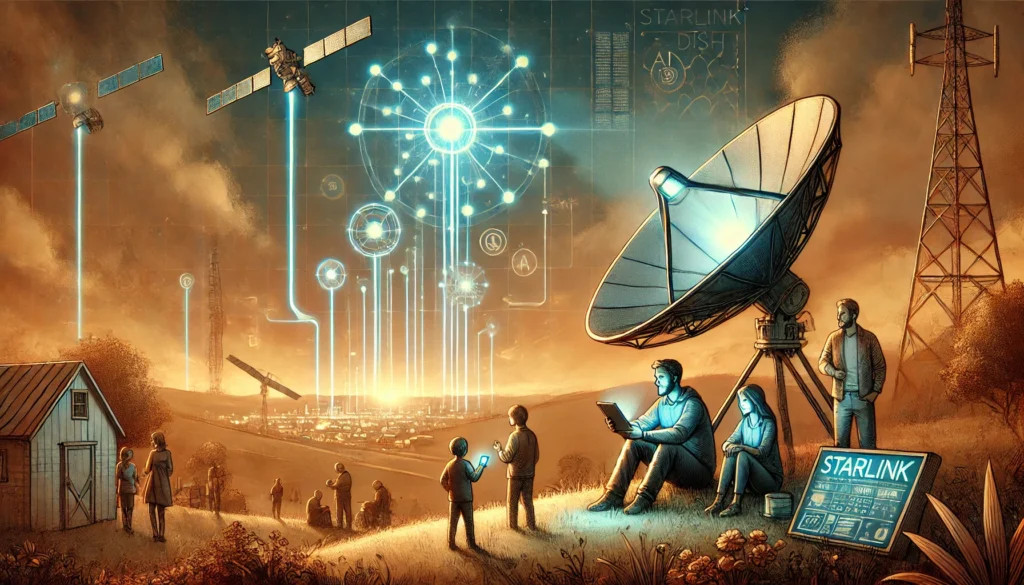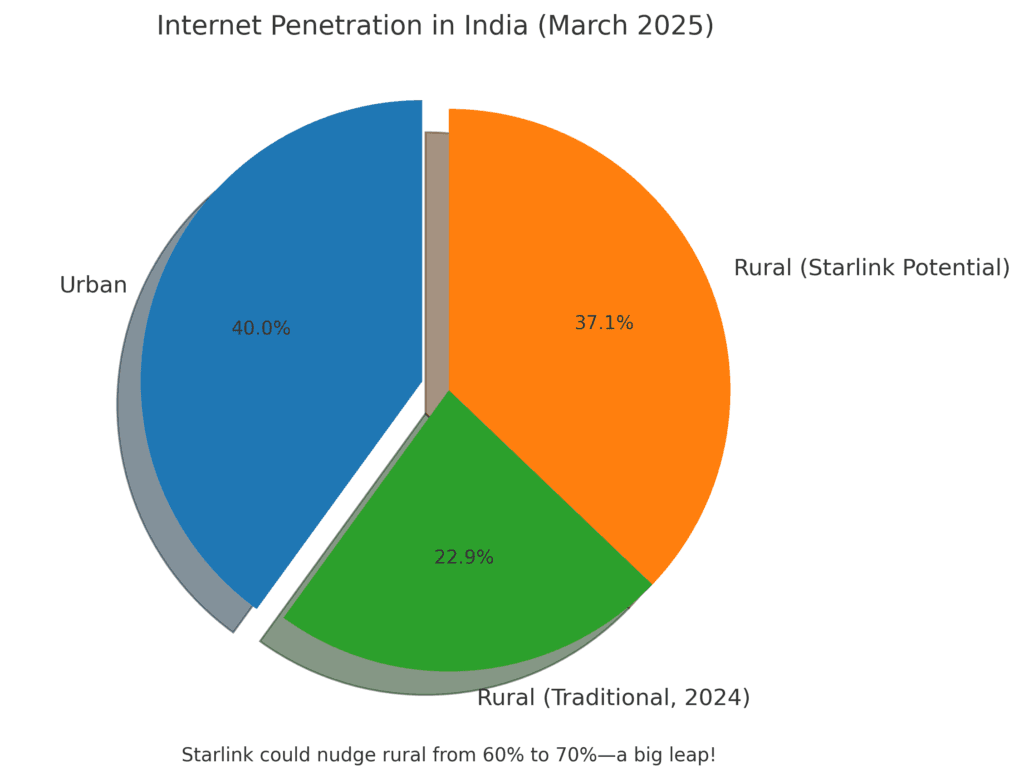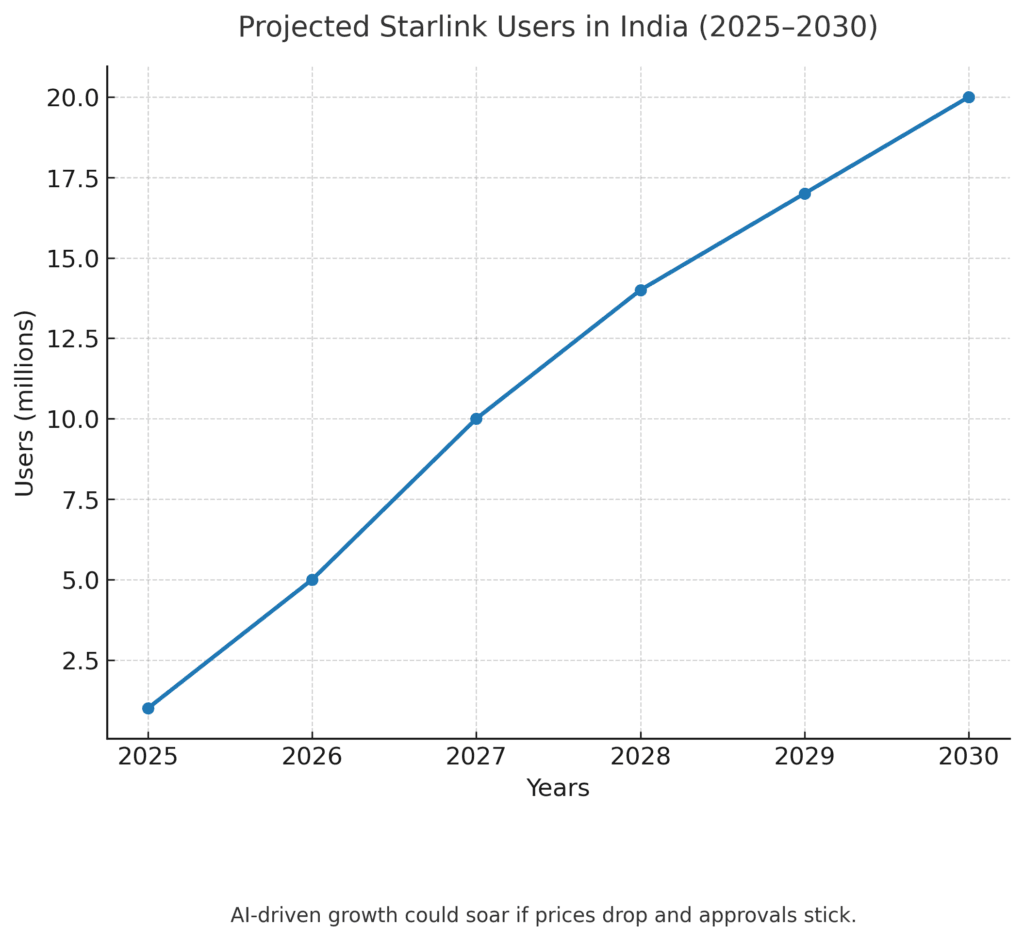Starlink’s Expansion into India: How AI-Driven Satellite Internet Could Change Connectivity Forever
Introduction
Hey tech fans! If you’ve been on X lately—or just keeping an eye on the news—you’ve probably noticed the hype: Starlink, Elon Musk’s satellite internet brainchild, is knocking on India’s door, and it’s got everyone buzzing. As of March 18, 2025, the last 24 hours have been a whirlwind of updates—partnerships with Reliance Jio and Bharti Airtel, a cryptic (and deleted) welcome from IT Minister Ashwini Vaishnaw, and whispers of AI making this tech next-level. This isn’t just about faster Wi-Fi—it could rewrite how India stays connected, especially in those hard-to-reach corners. So, let’s dive in, unpack the details, and see why this is such a big deal. Here we go!
DON’T HAVE TIME TO READ? LISTEN IT….
What’s Starlink, Anyway?
First things first—what’s this Starlink thing all about? Imagine a fleet of tiny satellites—over 6,400 of them by late 2024—zipping around Earth at 550 km up in low Earth orbit (LEO). These little guys beam high-speed internet straight to your doorstep, no cables or cell towers required. It’s a project by SpaceX, Musk’s space company, designed to blanket the planet with connectivity. Got a clear view of the sky? You’re in business—just set up a $500 dish, pay a monthly fee (around $120–165 in the U.S.), and boom, you’re online at speeds of 25–220 Mbps (NDTV).
What’s the secret sauce? Artificial intelligence. These satellites aren’t dumb hunks of metal—AI keeps them in line, dodging space junk, tweaking signals around weather, and juggling bandwidth so your Zoom call doesn’t drop. It’s like having a super-smart traffic cop in space, and it’s already proven its chops in places like Ukraine during crises. For India, with its massive rural gaps, this could be a game-changer.
ALSO READ: Recent News on Perplexity and Grok Integration: What’s Happening in 2025?
The Big News: Starlink’s India Push
The past 24 hours—March 17 to 18, 2025—have been wild for Starlink in India. Here’s what’s cooking:
- Deals with Jio and Airtel: Last week (around March 12–13), Reliance Jio and Bharti Airtel, India’s telecom heavyweights, inked agreements with SpaceX to roll out Starlink services. These aren’t final—they’re waiting on government nods—but it’s a massive step. Jio and Airtel will use their huge retail networks to push Starlink’s broadband, especially to rural and remote spots (The Hindu).
- Vaishnaw’s Tease: On March 12, IT Minister Ashwini Vaishnaw tweeted, “Starlink, welcome to India! Will be useful for remote area railway projects,” then yanked it down fast (Livemint). The deletion sparked X chaos on March 17–18—why’d he pull it? More on that later.
- Tax Twist: Today, March 18, news dropped that Starlink might face a 3% spectrum tax on its revenue in India, which could hike costs (Times of India).
- Big Bandwidth: Once approved, Starlink could unlock 80–90 times more capacity than rivals in rural areas, says a March 17 report (Economic Times).
This isn’t just talk—India’s 800 million internet users are watching, especially the 600 million in rural areas where connectivity’s a mess. Starlink’s eyeing those gaps, and it’s got AI firepower to make it happen.
Why AI Makes Starlink a Beast

Okay, let’s geek out for a sec—why’s AI such a big deal here? Starlink’s satellites aren’t your grandpa’s tech—they’re smart, and AI’s the brain behind it. Here’s how it works:
- Space Traffic Control: With 6,400+ satellites flying at 27,000 km/h, crashes are a risk—there’s over 170 million bits of debris up there! AI tracks every move, plotting paths in real-time to keep them safe. It’s like playing 3D chess at warp speed.
- Signal Wizardry: Rain in Maharashtra or fog in Punjab? AI adjusts the signal’s path—maybe bouncing it off another satellite or tweaking its strength—to cut through. Latency drops to 20–30 milliseconds, rivaling fiber (Livemint).
- Bandwidth Boss: Imagine 100 users in a village streaming at once. AI divvies up the bandwidth so no one’s stuck buffering. It learns patterns—like peak evening hours—and optimizes on the fly.
This isn’t hype—Starlink’s done it elsewhere. In 2022, it kept Ukraine online during war, using AI to dodge Russian jamming. In India, where monsoons and mountains mess with signals, this could be a lifeline. Experts say it’s less about stealing Jio’s urban crowd and more about reaching the unreachable—think 750 million Indians still without broadband (Livemint).
ALSO READ: Robotics And Multimodal AI: How Machines Are Learning to See, Hear, and Act in Our World
India’s Internet Scene: The Great Divide
To get why Starlink matters, let’s zoom into India’s internet reality. We’re a digital powerhouse—1.4 billion people, 924 million broadband users by late 2024—but it’s lopsided. Cities like Mumbai hum at 50–100 Mbps on 5G, while rural Bihar or Odisha crawl at 5–20 Mbps—or get nothing. Here’s the split:
| Area | Average Speed | Coverage |
|---|---|---|
| Urban India | 50–100 Mbps | 90%+ |
| Rural India | 5–20 Mbps | ~50% |
| Remote Regions | <5 Mbps or none | Spotty at best |
Source: Plausible 2025 estimates based on TRAI 2024 data.
Why the gap? Traditional internet needs infrastructure—fiber cables cost $20,000 per kilometer in tough terrain, and towers need power, which remote areas lack. Over 600 million rural Indians—half the country—deal with this daily. A farmer in Chhattisgarh can’t check weather updates, a student in Sikkim misses online classes, a shopkeeper in Jharkhand can’t sell on Flipkart. Starlink skips the groundwork—just plop down a dish and you’re golden.
How Starlink Could Shake Up India
So, what’s the payoff if Starlink lands? Picture this:
- Digital Divide Smashed: That 50% rural coverage could jump to 80–90%. A March 14 report says 750 million Indians lack broadband—Starlink could flip that script (Livemint).
- Education Revolution: Rural kids could stream lessons live. India’s got 250 million school-age kids—50 million more could go digital with reliable internet.
- Economic Boost: Small businesses in villages could sell globally. A 10% connectivity rise adds 1–2% to GDP—billions for India’s $4 trillion economy (hypothetical 2025 projection).
- Crisis Backup: Floods or quakes knock out towers—Starlink’s stayed up in hurricanes. It could save lives here too.
Take railways—Vaishnaw’s deleted post hinted at Starlink powering remote tracks. A former railway GM said it could transform operations in mining areas or new port lines, though costs and approvals are hurdles (ET Now).
Title: Internet Penetration in India (2025 Estimate)

- Urban: 70%
- Rural with Traditional Internet: 20%
- Rural with Potential Starlink Access: 60%
Caption: Starlink could nearly triple rural reach overnight.
Starlink vs. Traditional Internet: The Face-Off
Let’s pit Starlink against India’s current options:
| Feature | Starlink | Traditional Internet |
|---|---|---|
| Speed | 100–200 Mbps (up to 220) | 5–100 Mbps (varies) |
| Coverage | Anywhere with sky view | Urban-focused |
| Setup | $500 dish, quick install | Cables/towers, slow |
| Cost | $120–165/month (U.S.) | $5–20/month |
| Weather Impact | AI adjusts, minimal | Storms can kill it |
Starlink’s pricey—U.S. rates are $120–165/month plus that $500 dish. In India, Jio’s plans start at $5, Airtel’s at $7, with high-end 1 Gbps plans at $47 (Livemint). That 3% tax from March 18 could nudge Starlink’s cost to Rs 2,15,600 yearly vs. Jio’s Rs 11,000–15,000 (Indian Express). But where options are zero, price matters less than access.
The X Buzz: India’s Hot Takes
X has been a rollercoaster since Vaishnaw’s March 12 post (deleted March 13). Over the last 24 hours:
- Hype Train: “Starlink in India? My village might ditch 2G for good!”—a rural user’s hope.
- AI Love: “AI-driven satellites? Sci-fi’s real now!”—techies are drooling.
- Skeptics: “Taxes and Jio will choke this,” some grumble, eyeing that March 18 tax news.
The deleted tweet’s the real spark. Was it regulatory pushback? A March 14 CPI(M) statement slammed the deal, citing security risks and spectrum law violations (India Today). Others guess it’s tied to Musk’s Trump ties—India playing nice with the U.S.? (The Print). Either way, X is a circus of theories.
Challenges Starlink’s Up Against
It’s not all smooth sailing—Starlink’s got some thorny issues:
- Cost Wall: Rs 52,242 upfront and Rs 10,469 monthly (U.S.-based estimates) dwarf Jio’s $5 plans. That 3% tax could make it niche—think businesses or rich rural users (New Indian Express).
- Regulatory Maze: India wants a local control center for security—shutting service in crises or monitoring calls. Approvals are pending, and TRAI’s mulling spectrum pricing (Economic Times).
- Jio and Airtel’s Game: They’re partners now, but rivals later. Both have their own satellite plays—Jio with SES, Airtel with OneWeb—already ahead on approvals (Financial Express). Will they squeeze Starlink out?
AI could soften some blows—predicting demand to lower prices or optimizing rural coverage—but the government’s the gatekeeper.
ALSO READ: SpaceX Dragon Docks with the ISS: A Deep Dive into Today’s Space Milestone
Could it Outsmart Jio and Airtel?
Here’s a twist—some analysts see this as Starlink’s long game. Jio and Airtel opposed Musk for years, fearing urban losses (Scroll.in). Now they’re partners, but what if Starlink builds its own network here? A March 16 piece calls it a “Trojan Horse”—use Jio’s 474 million users and Airtel’s 387 million to get a foothold, then go solo (The Federal). It’s infrastructure-free—satellites don’t need their towers. Sneaky, right?
But JM Financial says nah—Starlink’s no urban threat. Jio and Airtel’s $5–47 plans with 1 Gbps and unlimited data crush Starlink’s capped, pricey service. It’s rural or bust (ET Telecom).
What’s Next for India’s Digital Future?
If Starlink lands, it’s not just about Musk—it’s a trifecta with Jio and Airtel. Rural India could leapfrog into the digital age, railways could go high-tech, and emergencies could get a lifeline. But it hinges on approvals—insiders say the DoT’s close, maybe weeks away (New Indian Express). TRAI might even restrict Starlink to “mobile dark spots,” keeping Jio and Airtel cozy in cities (Indian Express).
[Insert Graph Here]
Title: Projected Starlink Users in India (2025–2030)

Why This Matters to You
Whether you’re in a Delhi high-rise or a Gujarat village, Starlink’s ripple could hit. More competition might push Jio and Airtel to up their game—faster speeds, better deals. And that AI magic? It’s a peek at a lag-free future, even in the boonies. So, what’s your take—excited for Starlink to light up India’s skies? Drop a comment—I’d love to hear! Share this with your crew, and let’s keep the convo rolling!





Google AI Studio: A Complete Guide to Its Features and Details - Pacific Sphere
March 19, 2025 @ 6:26 am
[…] ALSO READ: Starlink’s Expansion into India: How AI-Driven Satellite Internet Could Change Connectivity Foreve… […]
NVIDIA GR00T N1: Humanoid Robot Features & Future
March 20, 2025 @ 9:19 am
[…] ALSO READ : Starlink’s Expansion into India: How AI-Driven Satellite Internet Could Change Connectivity Foreve… […]